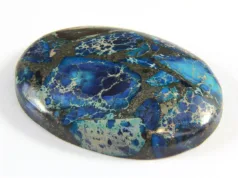Bismuth is a fascinating metal known for its unique properties and striking visual appeal. Among its various forms, synthetic bismuth crystals stand out due to their vibrant, rainbow-like colors. These colorful crystals are created by cooling molten bismuth in a controlled environment, allowing it to form intricate, stepped structures.
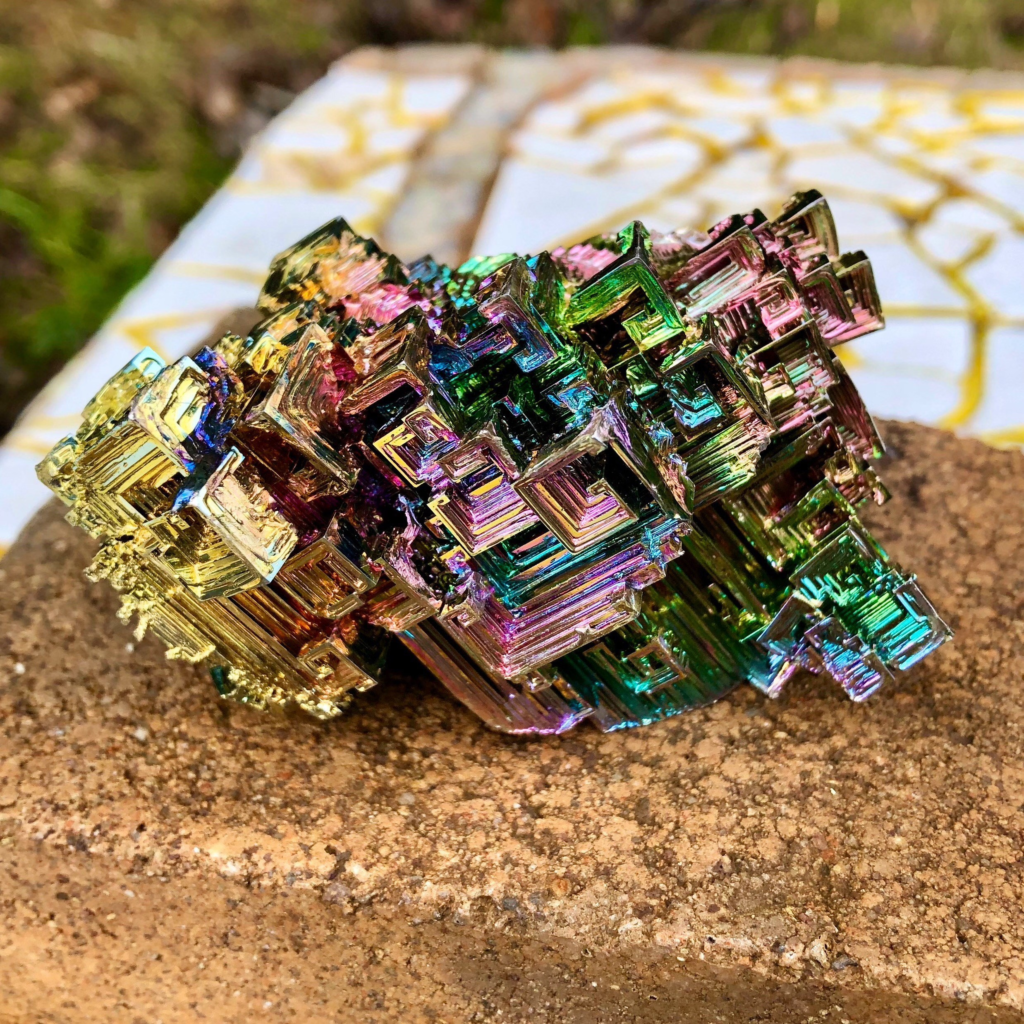
The striking iridescence of synthetic bismuth crystals results from a thin layer of oxide that forms on their surface. This layer creates interference effects with light, producing a spectrum of colors that range from pink and blue to green and gold. The process of making these crystals involves carefully managing the cooling rate and purity of the bismuth to achieve the desired aesthetic effect.
Synthetic bismuth crystals are popular in decorative items and educational demonstrations. Their dazzling appearance and complex crystal formations make them a favorite among collectors and enthusiasts, showcasing the beauty that can be achieved with this versatile metal.
Bismuth is a heavy, brittle metal with the atomic number 83 and the symbol Bi. It is known for its distinctive, iridescent appearance when oxidized, displaying hues of pink, blue, and green. The metal has a relatively low melting point of about 271.4°C (520.5°F) and is often found in nature as a compound rather than in its pure form. Bismuth is a poor conductor of electricity but is an excellent thermal conductor. It is chemically stable in air and water, though it can slowly oxidize. Its most notable physical property is its density, which is high compared to other metals, contributing to its heaviness. Bismuth is also characterized by its low toxicity compared to other heavy metals, making it a safer alternative in various applications.
Historical Use and Discovery
Bismuth has been known since antiquity, with early uses dating back to ancient civilizations. The metal was utilized in alloys and as a component in some traditional medicines. Its discovery as a distinct element, however, is credited to the German chemist Claude François Geoffroy, who in the early 18th century recognized it as a separate entity from lead, which it had previously been confused with. Geoffroy’s work laid the groundwork for understanding bismuth’s unique properties and applications. In the 19th century, with the development of modern chemistry, bismuth’s applications expanded, including its use in cosmetics, pharmaceuticals, and low-melting alloys. Its distinctive color and low toxicity further established its place in a variety of industrial and scientific applications, marking its importance in both historical and contemporary contexts.
Name: From the German weisse masse, later wismuth, white mass.
Mineral Group: Arsenic group.
Cell Data: Space Group: R3m. a = 4.546 c = 11.860 Z = 6
Association: Chalcopyrite, arsenopyrite, pyrrhotite, pyrite, cobaltite, nickeline, breithauptite, skutterudite, safflorite, bismuthinite, silver, cubanite, molybdenite, sphalerite, galena, scheelite, wolframite, calcite, barite, quartz.
Properties of Bismuth
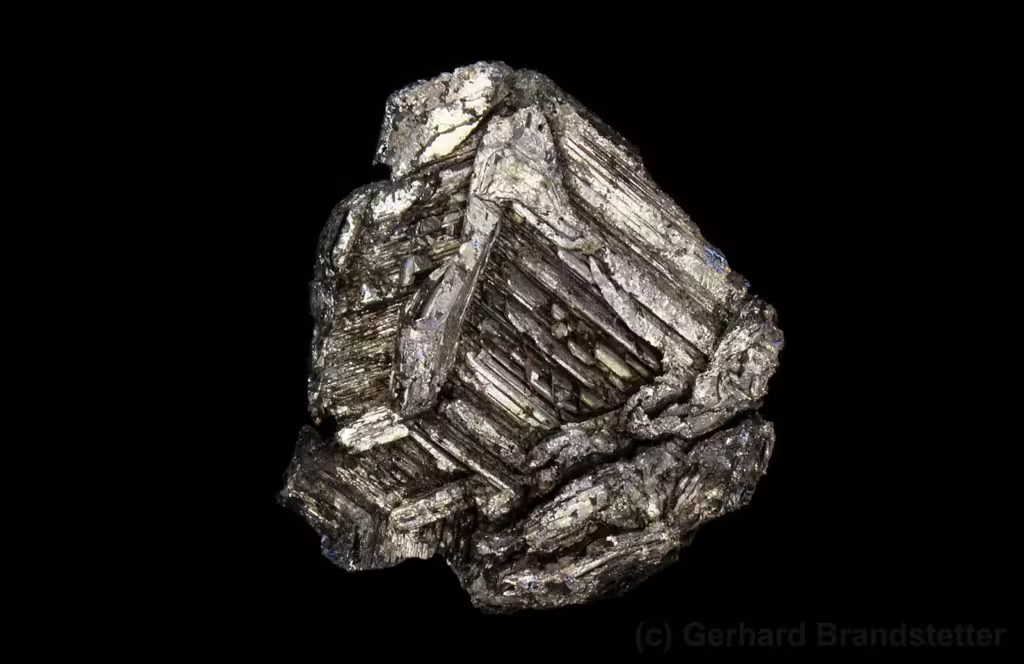
Physical Properties
Bismuth is a heavy, brittle metal with a silvery-white appearance that can develop an iridescent sheen when oxidized. It has a relatively high density of about 9.78 g/cm³, which is one of its notable physical characteristics. The metal is distinguished by its low thermal and electrical conductivity compared to other metals. Bismuth has a relatively low melting point of approximately 271.4°C (520.5°F), which is significantly lower than many other metals. This property makes it useful in applications requiring low-melting alloys. Additionally, bismuth exhibits a unique property in its crystal structure: when it solidifies, it expands rather than contracting, which is unusual for most metals.
Chemical Properties
Chemically, bismuth is relatively stable compared to other heavy metals. It does not react readily with air at room temperature but can form a layer of bismuth oxide (Bi₂O₃) when exposed to oxygen. Bismuth is also resistant to corrosion in water and most acids, although it does react with strong acids like hydrochloric acid to form bismuth chloride (BiCl₃). In alkaline solutions, bismuth can dissolve to form bismuthates, such as sodium bismuthate (NaBiO₃). The metal does not readily form complex compounds compared to other elements, but its compounds are often used in various applications due to their low toxicity. Bismuth compounds, such as bismuth subsalicylate, are commonly used in pharmaceuticals, including medications for digestive issues.
Optical Properties
Bismuth exhibits several interesting optical properties, although it’s not typically considered a major player in optical applications compared to other materials like silicon or various compounds used in optics. Nonetheless, here are some optical properties of bismuth:
- Refraction: Bismuth has a refractive index of approximately 1.9 for visible light. This means that light passing through or interacting with bismuth will be refracted, or bent, as it enters or exits the material.
- Reflection: Like most metals, bismuth exhibits reflectivity. However, it’s not as reflective as some other metals like silver or aluminum. The reflectivity of bismuth can vary depending on factors such as surface finish and purity.
- Coloration: Bismuth is known for its iridescent oxide layer that forms on its surface when exposed to air. This oxide layer can produce a range of colors, including purples, blues, greens, and yellows. This property makes bismuth crystals popular for decorative and artistic purposes.
- Transparency: Bismuth is generally considered opaque to visible light, meaning that light cannot pass through it. However, in thin films or certain crystal structures, bismuth can exhibit some degree of transparency, particularly in the infrared part of the spectrum.
- Photoluminescence: Under certain conditions, bismuth compounds can exhibit photoluminescence, emitting light when excited by photons. This property is exploited in some applications such as luminescent materials for displays and sensors.
- Optical Birefringence: Some bismuth-containing compounds, particularly certain crystals, exhibit optical birefringence. This means that they have different refractive indices for light polarized in different directions, resulting in double refraction.
While bismuth’s optical properties are not as extensively studied or utilized as those of some other materials, they still contribute to its unique characteristics and make it suitable for specific applications, particularly in decorative items, art, and certain scientific studies.
Identification and Classification
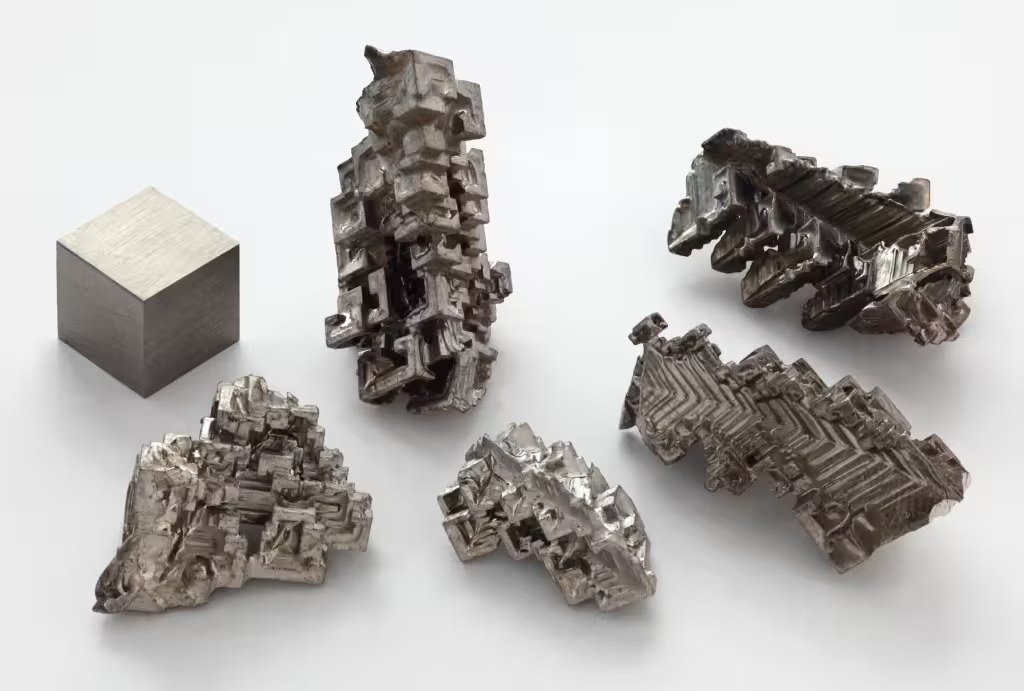
How to Identify Bismuth in the Field
Identifying bismuth in the field can be challenging due to its rarity and the similar appearance of its minerals to other metals. However, several methods and characteristics can help in its identification:
- Physical Characteristics: Bismuth metal has a distinct appearance, often exhibiting an iridescent, rainbow-like sheen due to the formation of an oxide layer. It is brittle and has a silvery-white color. Bismuth ores can be recognized by their characteristic colors and the presence of minerals like bismuthinite or bismite.
- Density Test: Bismuth is a heavy metal with a density of about 9.78 g/cm³. By performing a density test (e.g., measuring the weight of a sample and its volume), you can determine if the sample has a density consistent with bismuth.
- Chemical Tests: In the field, simple chemical tests can help identify bismuth. For example, bismuth can be tested using dilute acids to see if it reacts to form bismuth salts. Bismuth compounds often produce a white or yellow precipitate in specific reactions.
- Magnetic Test: Bismuth is diamagnetic, meaning it is repelled by magnetic fields. While this property is subtle and may require a strong magnet, it can be used to differentiate bismuth from ferromagnetic materials.
- X-ray Fluorescence (XRF): Portable XRF analyzers can provide a quick and accurate way to identify bismuth in the field. These devices measure the fluorescent X-rays emitted by a sample when exposed to a primary X-ray source, allowing for precise identification of elements.
Classification and Types of Bismuth Minerals
Bismuth minerals are classified based on their chemical composition and crystal structure. The primary bismuth minerals include:
- Bismuthinite (Bi₂S₃): This is one of the most important bismuth ores. It appears as metallic, grayish to black crystals and is often found in hydrothermal veins. Bismuthinite has a high density and a lead-gray color.
- Bismite (Bi₂O₃): Bismite is an oxide mineral that forms as an oxidation product of bismuth-containing ores. It is usually yellowish or brownish and has a relatively high density.
- Bismuth Copper (Cu₁₋ₓBiₓ): This mineral is a solid solution of copper and bismuth. It can be found in copper deposits and is often associated with other copper and bismuth minerals.
- Bismuthinite-Bismite Series: This series includes minerals that range between bismuthinite (Bi₂S₃) and bismite (Bi₂O₃), showing intermediate properties.
- Tetradymite (Bi₂Te₃): Although primarily a telluride, tetradymite contains bismuth and is used in thermoelectric applications. It has a metallic luster and appears as silver-gray crystals.
In summary, identifying bismuth in the field involves a combination of visual inspection, physical tests, and chemical analyses. The classification of bismuth minerals is based on their composition and crystal structure, with key minerals including bismuthinite, bismite, and tetradymite.
Formation and Occurrence
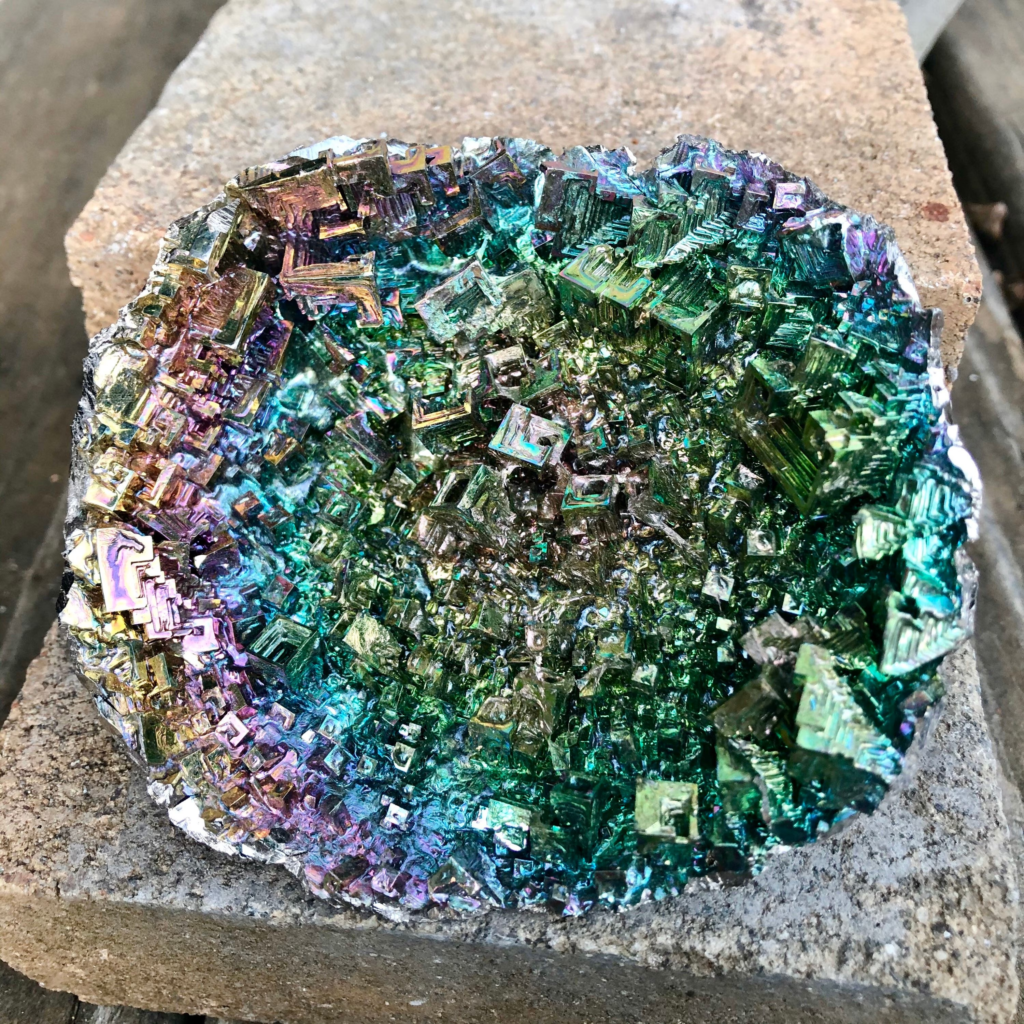
Geological Formations and Environments
Bismuth is relatively rare in the Earth’s crust and is typically found in minute quantities within certain geological formations. It primarily occurs in hydrothermal veins, which are mineral deposits formed from hot, mineral-rich fluids circulating through rocks. Bismuth can also be found in pegmatitic rocks, which are formed from the crystallization of magma in the final stages of igneous activity. Additionally, it can be associated with lead, copper, and tin ores in these mineral deposits. Bismuth is often found in compounds such as bismuthinite (Bi₂S₃), which forms from the cooling of molten rock or from mineral-rich solutions in hydrothermal environments.
Common Locations Where Bismuth is Found
Bismuth is found in several locations around the world, though it is not as abundant as other metals. Notable sources include:
- China: One of the largest producers of bismuth, with significant deposits and mining operations.
- Bolivia: Hosts important bismuth deposits, often associated with tin mining activities.
- Canada: Known for its bismuth resources, particularly in the province of Quebec, where it is mined as a byproduct of other metals.
- Mexico: Another significant producer, with bismuth found in various mineral deposits.
- Australia: Contains bismuth in several mining operations, usually as a byproduct of gold and other metal mining.
Mining and Extraction Methods
Bismuth is typically extracted as a byproduct of mining other metals, such as lead, copper, or tin. The extraction process involves several steps:
Purification: The final step involves purifying the bismuth to meet industrial standards, ensuring it is suitable for various applications, including electronics, pharmaceuticals, and alloys.
Mining: Bismuth is mined either directly from bismuth-containing ores, such as bismuthinite, or as a byproduct of other metal ores. The ores are extracted using conventional mining methods, including underground mining or open-pit mining.
Crushing and Grinding: The mined ore is crushed and ground to liberate the bismuth minerals from the surrounding rock.
Concentration: The ground ore is processed to concentrate the bismuth-containing minerals. This often involves flotation, where chemicals are added to separate bismuth minerals from other materials.
Extraction: Bismuth is extracted from the concentrated ore using various methods. In many cases, it is recovered from lead, copper, or tin smelting processes, where it accumulates in the slag or as a residue. Specialized processes, such as solvent extraction or precipitation, may be used to separate bismuth from these mixtures.
Refining: The extracted bismuth is further refined to remove impurities. This involves processes like electrolysis or chemical reduction to obtain pure bismuth metal or bismuth compounds.
Bismuth Crystals: Rainbow Synthetic
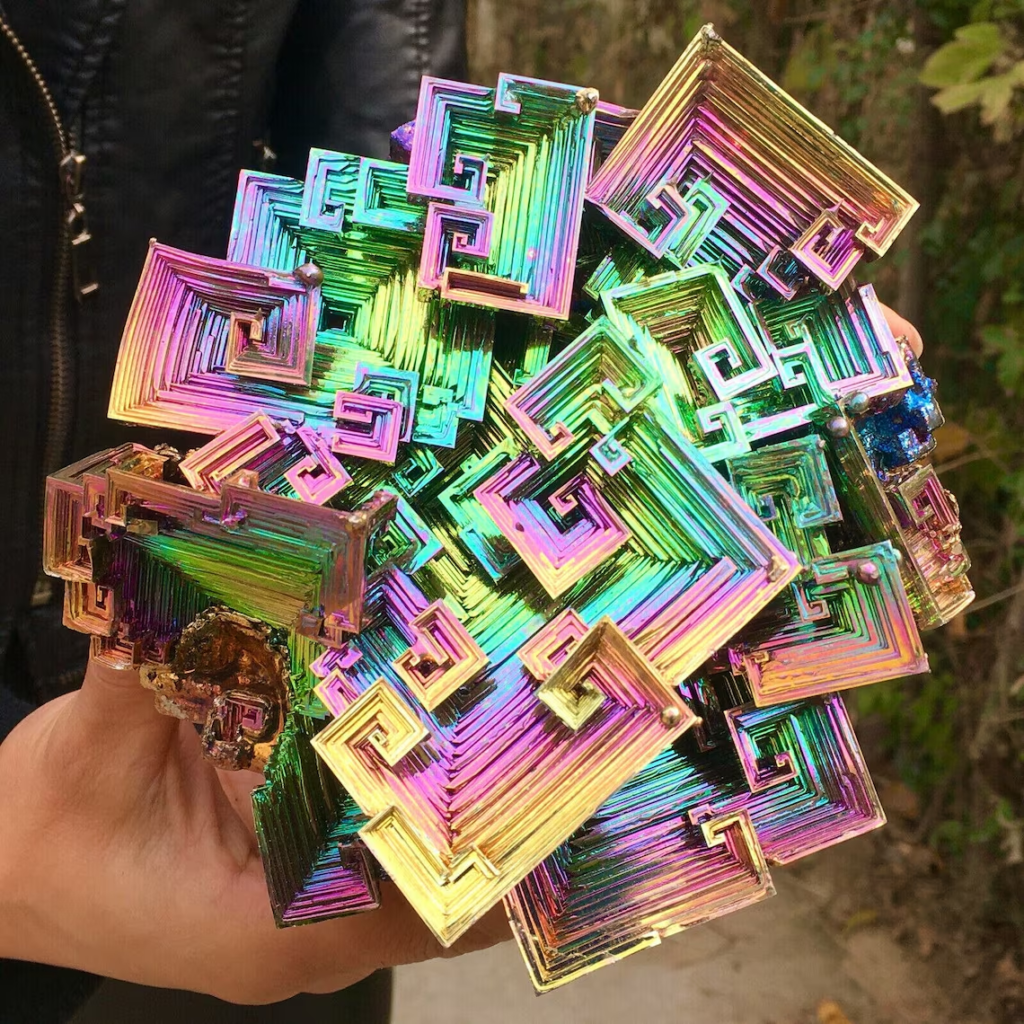
Bismuth crystals are known for their striking and colorful appearance, often displaying a rainbow-like iridescence. This phenomenon is due to the formation of a thin oxide layer on the surface of the crystals, which creates a spectrum of colors through interference.
Formation and Appearance
- Crystallization: Bismuth crystals form when molten bismuth cools and solidifies. As the metal cools, it forms complex, geometric crystal structures with stepped layers or stair-like formations. These structures can be quite intricate and visually captivating.
- Iridescence: The rainbow effect on bismuth crystals is produced by the interference of light waves reflecting off the thin oxide layer that forms on the surface of the crystal. The thickness of the oxide layer varies in different areas of the crystal, leading to different colors being reflected.
Synthetic Creation
- Controlled Cooling: To create synthetic bismuth crystals with a rainbow effect, precise control over the cooling process is essential. This is typically done by melting bismuth and allowing it to cool slowly in a controlled environment. The cooling rate affects the formation of the crystal structures and the resulting colors.
- Purity and Environment: The purity of the bismuth and the conditions under which it is cooled (such as temperature and the presence of other elements) can influence the appearance of the crystals. Pure bismuth and a controlled environment generally produce the most vivid and striking colors.
Applications and Uses
- Decorative Items: Rainbow bismuth crystals are often used as decorative items due to their unique and colorful appearance. They are popular in jewelry, ornaments, and as collector’s pieces.
- Educational Tools: These crystals are also used in educational settings to demonstrate concepts related to crystallography, light interference, and the properties of metals.
In Summary
Rainbow bismuth crystals are synthetic creations that showcase a dazzling array of colors due to the interference effects of light reflecting off a thin oxide layer. Their aesthetic appeal and unique formation process make them popular for decorative and educational purposes.
Uses and Applications

Industrial Uses
- Alloys: Bismuth is used in various alloys due to its low melting point and unique properties. It is a key component in low-melting alloys, which are used in applications requiring materials that melt at relatively low temperatures, such as in fire detection systems and soldering. Bismuth is also used in alloys for making metal gauges, certain types of bearings, and as a replacement for lead in some applications to reduce toxicity.
- Pharmaceuticals: Bismuth compounds, notably bismuth subsalicylate (Pepto-Bismol), are widely used in medicine. They are effective in treating gastrointestinal issues such as diarrhea, indigestion, and nausea. Bismuth compounds also have antibacterial properties and are used in treatments for Helicobacter pylori infection, which is linked to peptic ulcers.
- Cosmetics: Bismuth oxychloride is used in cosmetics, particularly in makeup products like powders and foundations. It provides a pearlescent sheen and contributes to a smooth texture, enhancing the aesthetic quality of cosmetic products.
Technological Applications
- Electronics: Bismuth is utilized in electronics for its unique properties. It is used in the production of certain types of semiconductors and thermoelectric materials, where its ability to conduct heat but not electricity is advantageous. Bismuth-based materials are employed in thermoelectric devices that convert temperature differences into electrical power.
- Nuclear Applications: Bismuth has applications in nuclear technology due to its ability to absorb neutrons. It is used in nuclear reactors as a component of control rods and as a coolant in certain reactor designs. Bismuth compounds are also utilized in the production of bismuth-based nuclear fuels and in radiation shielding materials.
In summary, bismuth’s diverse properties make it valuable across a range of industries, from medicine and cosmetics to electronics and nuclear technology. Its applications leverage its unique characteristics, such as low melting point, low toxicity, and neutron absorption, to address specific needs in various fields.
Distribution
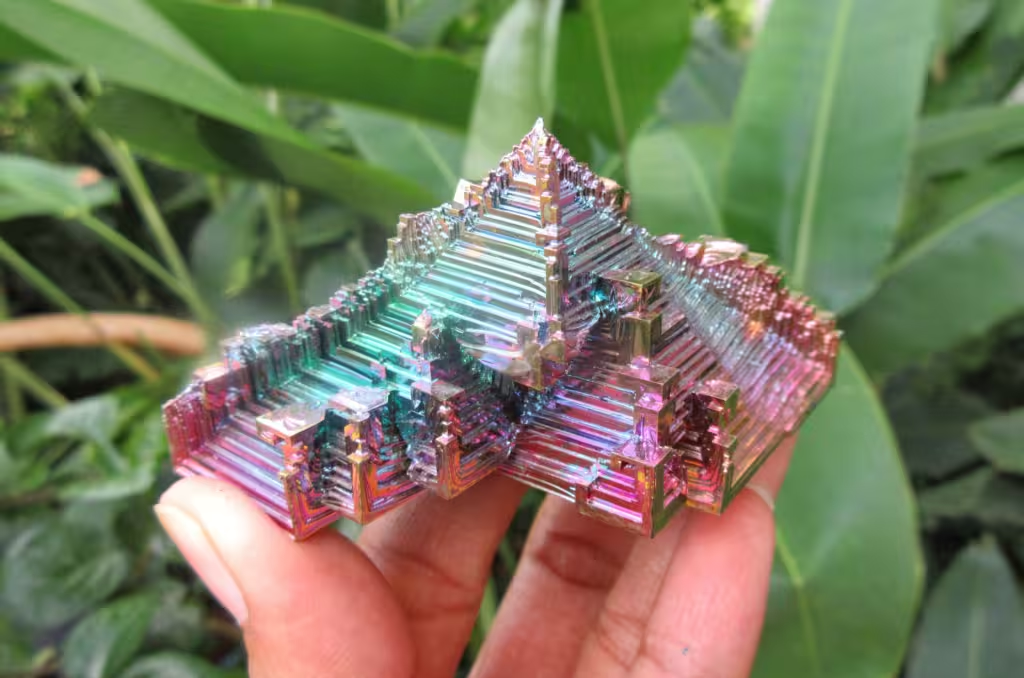
The distribution of bismuth in nature is relatively widespread, but it tends to occur in relatively low concentrations compared to more abundant elements. Here’s a breakdown of its distribution:
- Earth’s Crust: Bismuth is present in the Earth’s crust at an average concentration of around 0.2 parts per million (ppm). This makes it one of the less abundant elements in the Earth’s crust.
- Mineral Deposits: Bismuth is typically found in association with other metal ores, particularly those of lead, copper, zinc, and silver. It occurs in various mineral forms, including bismuthinite (Bi2S3), bismite (Bi2O3), and native bismuth. These minerals are often found in hydrothermal veins, pegmatites, and other geological formations where ore deposits are formed.
- Global Production: The largest producers of bismuth are China, Peru, Mexico, and Canada, although smaller quantities are produced in several other countries as well. China, in particular, dominates global production, accounting for a significant portion of the world’s bismuth supply.
- By-Product of Other Metal Extraction: Bismuth is often obtained as a by-product of the refining of lead, copper, tin, silver, and gold ores. It is extracted from these ores through various processes such as smelting, roasting, and electrolysis.
- Industrial Use and Distribution: Once extracted, bismuth is utilized in various industries such as metallurgy, pharmaceuticals, cosmetics, electronics, and pyrotechnics. Its distribution in these industries depends on factors such as demand, availability, and economic considerations.
- Global Trade: Bismuth and its compounds are traded globally, with countries importing and exporting bismuth-based products for various applications. China, as the largest producer, also plays a significant role in the global trade of bismuth.
Overall, while bismuth is relatively rare compared to some other elements, it is still widely distributed and plays important roles in various industrial and commercial sectors around the world.



























